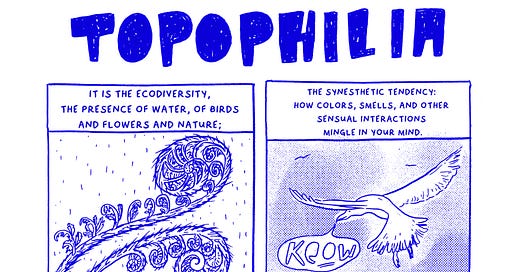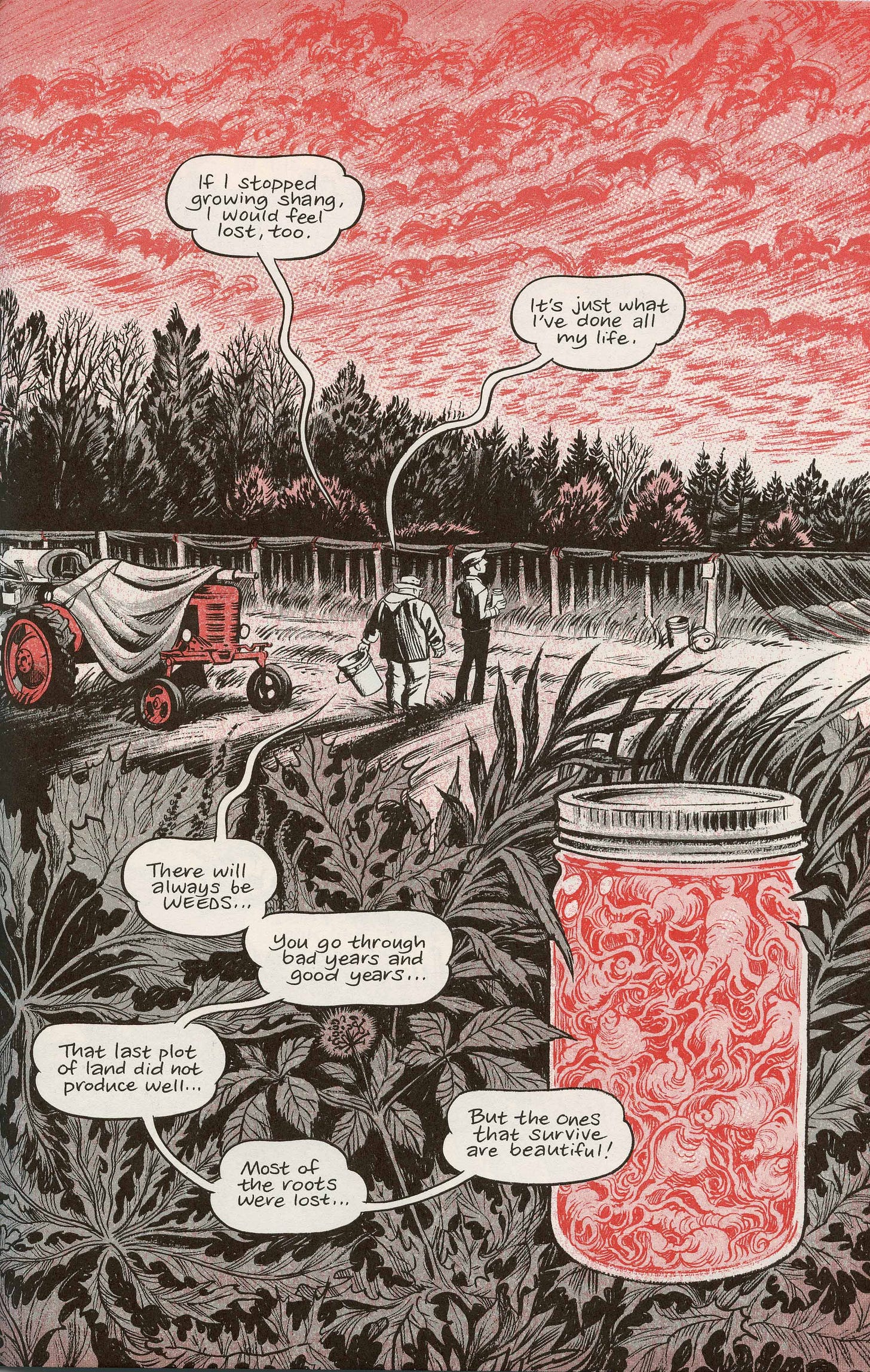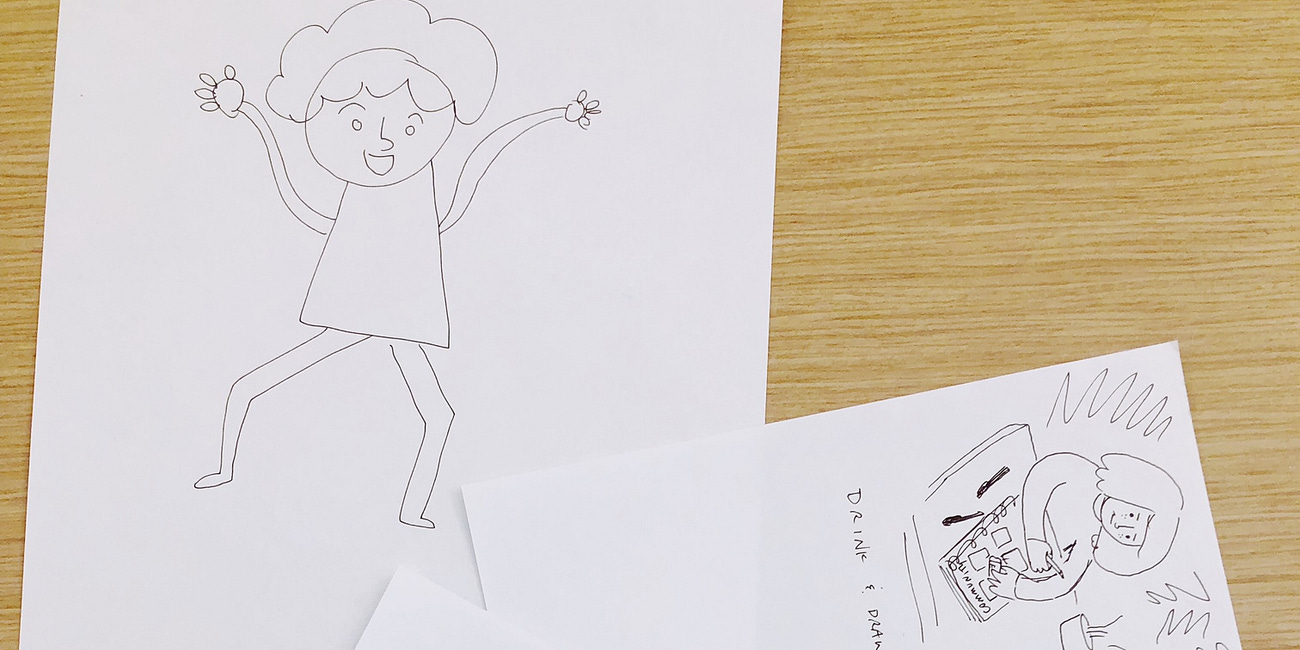We spend so much our time placeless. For at least eight hours a day throughout the week, I’m in my email inbox, spreadsheets and reports, shared documents, learning management software, InDesign, and social media. I’m at the computer and the world falls away; I’m on the couch with the phone in my hand, not present even in my own house. My mind looks at everything and nothing—it’s mostly abstract demands for abstract problems and advertisements. Perhaps that’s why I’m thinking about place. After all, you need ground in order to “ground” or “re-ground” yourself. I’m thinking about the many ways that we love a place, how place writes itself into us, and transforms who we are and how we think. Topophilia describes a profound love of a place or a specific environment (from the Greek topos, place, and -philia, affection). Comics, with their blend of image and narrative, seem like such a great way to explore topophilia of a certain locale. So, I thought it would be fun to explore how comics center place.
I want to start with a question: what are your favorite graphic memoirs about a certain place? Graphic memoirs that feel like they couldn’t be removed from the place they are set? That make place a character of its own?
Background, Setting, or Character?
Last year, I taught Scott McCloud’s Making Comics again, and in it, he discusses building a drawn world for characters to inhabit. McCloud dives more into the technical approach to drawing 3D landscapes, including notes on vanishing points and horizon lines, and his drawings are wonderfully complex, but they tend to intimidate my beginning comics students, many of whom have no drawing experience (more on this in a later post). I am not convinced that place must be fully rendered for it to come alive on the page. Eleanor Davis does a wonderful job of creating a sense of place with a few loose lines in her travelogue You, a Bike & a Road. But McCloud does start to scratch at an interesting distinction between a background and a setting. Specifically, he advises you to quit thinking about the details of your drawn world as “background.” It’s a comment I have been thinking a lot about.
Think about it: backgrounds are functional. They show characters in a space. They provide context as to where something is happening. They might establish mood and tone, but ultimately the emphasis is on the characters and not their world. Often backgrounds are omitted entirely, and the panel will show only a talking head and its speech bubble. (I am very guilty of this habit.) Backgrounds are rarely central to the story.
Backgrounds start to shift into settings and into worlds when their details are more specific—the couch shows a hint of the owner’s personality; the eyes move on the Kit-Cat clock. What details make the world feel both alive and inhabited by a specific person?
In creative writing craft lessons, setting is often discussed as time, place, and environment. Time includes the historical era, the time year and time of day, and also the temporal span of the action. Place is often the immediate setting, the natural and built environment, and the city, country, etc. where the action takes place (this often includes cultural information as well). Environment includes the weather, the vibe of the setting (its atmosphere or mood), and the sensory details. For example, in addition to what you see, how does the place smell?
As the world of the comic becomes more immersive, it might even dynamic enough to shape the story and thus become a character in its own right.
The distinction between background and setting is more than a technical concern. Drawing place in a panel does more than give a “ground” for a figure to stand on; it provides a kind of context that breathes life into a narrative. Even a few loose lines can specifically and intentionally communicate both the moment and the environment’s personality and impact. The emotional and the sensory experience intertwine in our experience and rendering of place.
Over the course of couple newsletters (not consecutively), I will be analyzing how this relationship with place is built on the page and conveyed through panels.
In case you missed it; some of the work Nora and I have done thinking about place:
Comics on the Road
This week we are presenting at the Southwest Popular/American Culture Association Conference in Albuquerque. Here’s a little preview of our presentation for those of you who can’t make it.
Asynchronous Book Club: All Our Ordinary Stories
We were lucky to get an advance copy of All Our Ordinary Stories, which is officially released on September 24. We previously interviewed Teresa Wong as part of our monthly interview series and discussed her book Dear Scarlet in our presentation “Motherhood as Crisis: Women Comics Creators Confront Identities in Flux” at the University of Florida (
Feeding Ghosts Book Club
Call up your book club—or a circle of friends, or join our comment thread—and a grab a copy of Feeding Ghosts, our featured book for a guided discussion and creative activity.
Drawing Out Dream Communities
I recently had the pleasure of facilitating a comics workshop at the University of New Mexico Honors College. This workshop focused on dreaming up one’s ideal community using comics as an interdisciplinary arts approach to visualize and create it. Since comics make visible, tangible, and concrete even the most abstract concepts–whether that’s an emotion…










Oh my goodness! This is exactly what I’ve been thinking about lately as I work on my comic! And even have Ginseng Roots open frequently as an incredibly impossibly high mentor text. Thanks for sharing your thoughts on this!
I wholeheartedly agree! There is so little real estate in comix, don’t waste a millimeter. Your character’s setting needs as much attention as your character because it is also telling the story. And then, when the character needs more focus, you can soft-pedal that background (after having established it, so we know it’s there) and give the reader’s eyes a little rest. It’s a lovely dance.